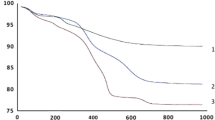Abstract
A universal conversion solid-electrolyte reactor (SER) based on zirconium dioxide stabilized by yttrium oxide is developed. It ensures the complete oxidation of organic compounds of complex molecular structure in different physical states or the complete reduction of water and organic oxygen-containing substances in a flow of helium carrier gas. The optimum oxidation operation mode of the solid-electrolyte reactor is the mode ensuring the complete oxidation of organic compounds at the boundary line of the oxidation of organic compounds and, at the same time, prevents the inflow of oxygen from the environment to the carrier gas. The potential of the working electrode selected for carrying out experiments was equal to–175 mV (oxidation operation mode). The temperature of the reactor was 940–950oC. The standard deviations δ13СVPDB for organic substances oxidized by SER varied from 0.11 to 0.57‰ and were smaller than standard deviations in the oxidation of corresponding compounds in a commercial reactor. In using the SER–IRMS method (isotope ratio mass spectrometry combined with the solid-electrolyte reactor), a minimum amount of water (60–100 ng) was required. Standard deviations δDVSMOW attained using SER and using a commercial pyrolytic reactor were close to each other. Because of the simplicity and reliability of the design, the developed SER can successfully replace commercial oxidation and reduction reactors in isotope ratio mass spectrometry. In addition, the solid-electrolyte reactor can serve as a chromatographic detector, requiring no calibration in contrast to other detectors.
Similar content being viewed by others
References
S. Bilk, and A. Mosandl, “Measurements by gas chromatography/ pyrolysis/mass spectrometry: fundamental conditions in 2H/1H isotope ratio analysis,” Rapid Commun. Mass Spectrom. 16 (5), 468–472 (2002).
W. A. Brand, H. Geilmann, R. Crosson, and C. W. Rella, “Cavity ring–down spectroscopy versus high–temperature conversion isotope ratio mass spectrometry; a case study on d2H and d18O of pure water samples and alcohol/water mixture,” Rapid Commun. Mass Spectrom. 23 (12), 1879–1884 (2009).
Y. Cao, W. Liu, P. E. Sauer, Z. Wang, and Z. Li, “An evaluation of alumina reaction tube conditioning for high–precision 2H/1H isotope measurements via gas chromatography/ thermal conversion/isotope ratio mass spectrometry,” Rapid Commun. Mass Spectrom. 26 (22), 2577–2583 (2012).
E. M. Galimov, Carbon Isotopes in Petroleum Geology (Nedra, Moscow, 1973) [in Russian].
M. Greule, A. Mosandl, John T. G. Hamilton, and F. Keppler, “A rapid and precise method for determination of D/H ratios of plant methoxyl groups,” Rapid Commun. Mass Spectrom. 22 (24), 3983–3988 (2008).
P. A. Groot, Handbook of Stable Isotope Analytical Techniques (Elsevier, Amsterdam–Boston–Heidelberg–London–New York–Oxford, 2004).
A. Gucciardi, P. E. Cogo, U. Traldi, S. Eaton, T. Darch, M. Simonato, and V. P. Carnielli, “Simplified method for microliter deuterium measurements in water and urine by gas chromatography–high–temperature conversion–isotope ratio mass spectrometry,” Rapid Commun. Mass Spectrum. 22 (13), 2097–2103 (2008).
P. Gupta, D. Noone, J. Galewsky, C. Sweeney, and B. H. Vaughn, “Demonstration of high–precision continuous measurements of water vapor isotopologues in laboratory and remote field deployments using wavelength–scanned cavity ring–down spectroscopy (WS–CRDS) technology,” Rapid Commun. Mass Spectrom. 23 (16), 2534–2542 (2009).
A. W. Hilkert, C. B. Douthitt, H. J. Schluter, and W. A. Brand, “Isotope ratio monitoring gas chromatography/ mass spectrometry of D/H by high temperature conversion isotope ratio mass spectrometry,” Rapid Commun. Mass Spectrom. 13 (13), 1226–1230 (1999).
D. E. Matthews and J. M. Hayes, “Isotope–ratio–monitoring gas chromatography–mass spectrometry,” Anal. Chem. 50, 1465–1473 (1978).
W. Meier-Augenstein, “Applied gas chromatography coupled to isotope ratio mass spectrometry,” J. Chromatogr. A. 842, 351–371 (1999).
S. Reinnicke, D. Juchelka, S. Steinbeiss, A. Meyer, A. Hilkert, and M. Elsner, “Gas chromatography/isotope ratio mass spectrometry of recalcitrant target compounds: performance of different combustion reactors and strategies for standardization,” Rapid Commun. Mass Spectrom. 26 (9), 1053–1060 (2012).
A. L. Sessions, “Isotope–ratio detection for gas chromatography,” J. Sep. Sci. 29, 1946–1961 (2006).
M. I. Tokarev, V. S. Fainberg, and Yu. S. Khodeev, “Modern facilities and prospects of mass spectrometr of light elements: a review,” Mass–Spectrom. 1 (3), 179–180 (2004).
Author information
Authors and Affiliations
Corresponding author
Rights and permissions
About this article
Cite this article
Sevastyanov, V.S., Babulevich, N.E. A universal method of sample preparation for liquid, solid, and gaseous samples based on a conversion solid-electrolyte reactor for measuring the isotope composition of light elements. Geochem. Int. 54, 1187–1195 (2016). https://doi.org/10.1134/S0016702916130152
Received:
Accepted:
Published:
Issue Date:
DOI: https://doi.org/10.1134/S0016702916130152



